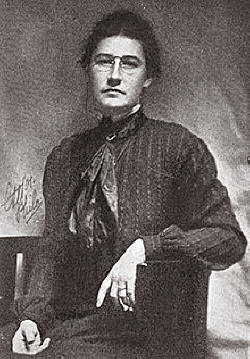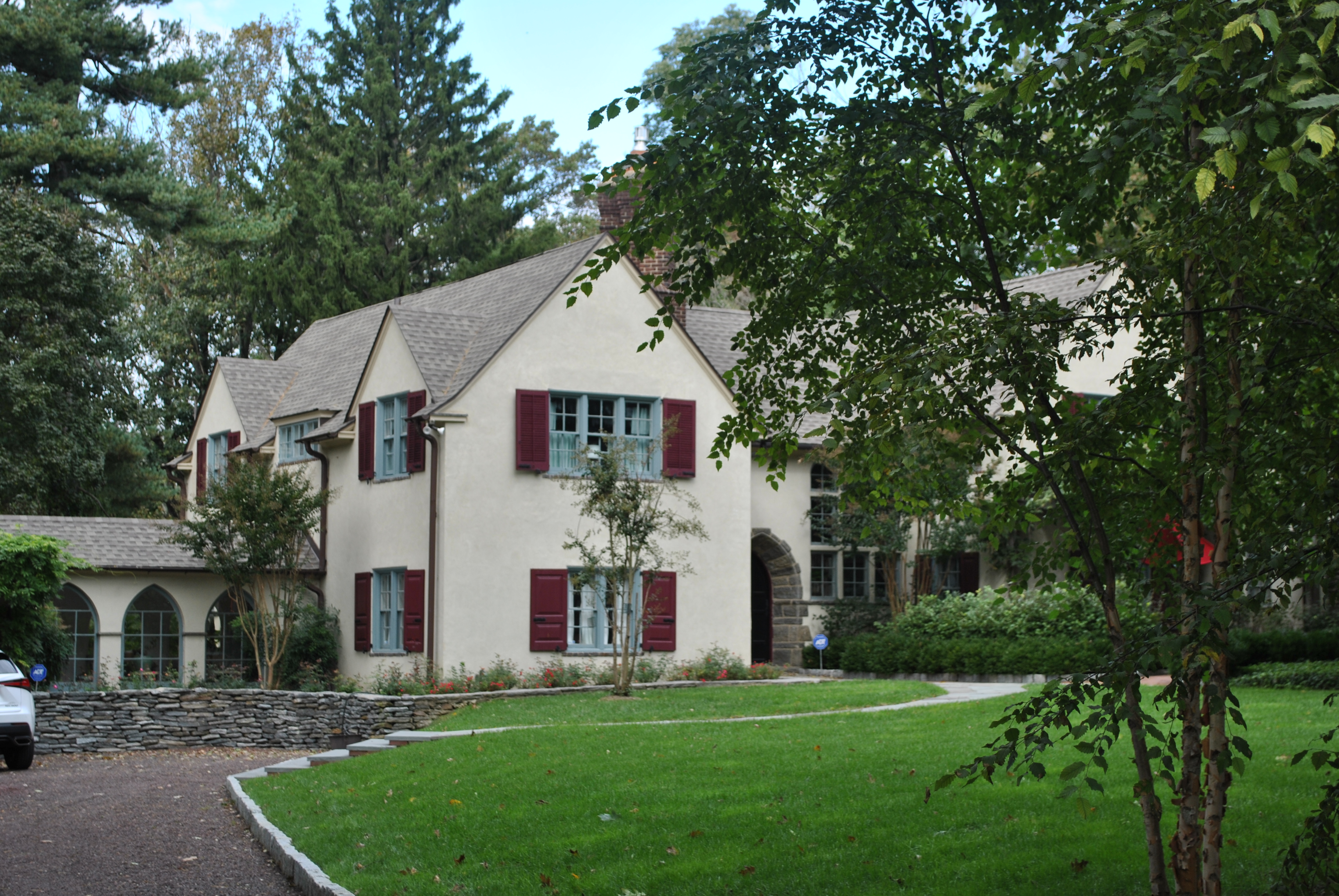Queer Places:
Pennsylvania Academy of the Fine Arts, 118-128 N Broad St, Philadelphia, PA 19102, Stati Uniti
Moore College of Art & Design, 1916 Race St, Philadelphia, PA 19103, Stati Uniti
Drexel University, 3141 Chestnut St, Philadelphia, PA 19104, Stati Uniti
1523 Chestnut St, Philadelphia, PA 19102
Red Rose Inn, 1308 Mt Pleasant Rd, Villanova, PA 19085
Cogslea, 617 St Georges Rd, Philadelphia, PA 19119, Stati Uniti
Cogshill, 601 St Georges Rd, Philadelphia, PA 19119
The Woodlands, 4000 Woodland Ave, Philadelphia, PA 19104, Stati Uniti
 Jessie Willcox Smith (September 6, 1863 – May 3, 1935) was a prominent
female illustrator in the United States during the Golden Age of American
illustration[2]
and "one of the greatest pure illustrators".[3]
She was a prolific contributor to respected books and magazines during the
late 19th and early 20th centuries. Smith illustrated stories and articles for
clients such as Century, Collier's, Leslie's Weekly,
Harper's, McClure's, Scribners, and the Ladies' Home
Journal. She had an ongoing relationship with Good Housekeeping,
which included the long-running Mother Goose series of illustrations and also
the creation of all of the Good Housekeeping covers from December 1917
to 1933. Among the more than 60 books that Smith illustrated were
Louisa May
Alcott's Little Women and An Old-Fashioned Girl, Henry
Wadsworth Longfellow's Evangeline, and Robert Louis Stevenson's A
Child's Garden of Verses.
Jessie Willcox Smith (September 6, 1863 – May 3, 1935) was a prominent
female illustrator in the United States during the Golden Age of American
illustration[2]
and "one of the greatest pure illustrators".[3]
She was a prolific contributor to respected books and magazines during the
late 19th and early 20th centuries. Smith illustrated stories and articles for
clients such as Century, Collier's, Leslie's Weekly,
Harper's, McClure's, Scribners, and the Ladies' Home
Journal. She had an ongoing relationship with Good Housekeeping,
which included the long-running Mother Goose series of illustrations and also
the creation of all of the Good Housekeeping covers from December 1917
to 1933. Among the more than 60 books that Smith illustrated were
Louisa May
Alcott's Little Women and An Old-Fashioned Girl, Henry
Wadsworth Longfellow's Evangeline, and Robert Louis Stevenson's A
Child's Garden of Verses.
Jessie Willcox Smith was born in the Mount Airy neighborhood of
Philadelphia, Pennsylvania. She was the youngest girl born to Charles Henry
Smith, an investment broker, and Katherine DeWitt Willcox Smith.[4][5]
Jessie attended private elementary schools. At the age of sixteen she was sent
to Cincinnati, Ohio to live with her cousins and finish her education. She
trained to be a teacher and taught kindergarten in 1883. However, Smith found
that the physical demands of working with children were too strenuous for her.[4][6]
Due to back problems, she had difficulty bending down to their level.[5]
Persuaded to attend one of her friend's[7]
or cousin's art classes, Smith realized she had a talent for drawing.[5][8]
In 1884[8][9]
or 1885,[5]
Smith attended the Philadelphia School of Design for Women (now Moore College
of Art and Design)[8]
and in 1885 attended the Pennsylvania Academy of the Fine Arts (PAFA) in
Philadelphia under Thomas
Eakins' and Thomas Anshutz' supervision.[5][9][10]
It was under Eakins that Smith began to use photography as a resource in her
illustrations. Although Eakins' demeanor could be difficult, particularly with
female students, he became one of her first major influences.[10]
In May 1888, while Smith was still at the Pennsylvania Academy, her
illustration Three Little Maidens All in a Row was published in the
St. Nicholas Magazine. Illustration was one artistic avenue in which women
could make a living at the time.[5]
At this time, creating illustrations for children's books or of family life
was considered an appropriate career for woman artists because it drew upon
maternal instincts. Alternatively, fine art that included life drawing was not
considered "ladylike."[11]
Illustration partly became viable due to both the improved color printing
processes and the resurgence in England of book design.[12]
Smith graduated from PAFA in June 1888.[7]
The same year, she was hired for an entry-level position in the advertising
department of the first magazine for women, the Ladies' Home Journal.
Smith's responsibilities were finishing rough sketches, designing borders, and
preparing advertising art for the magazine.[6][13]
In this role, she illustrated the book of poetry New and True: rhymes and
rhythms and histories droll for boys and girls from pole to pole (1892) by
Mary Wiley Staver.[7]
During her time at the Ladies' Home Journal, Smith enrolled in 1894
in Saturday classes taught by Howard Pyle at Drexel University.[5][14]
She was in his first class, which was almost 50% female.[13]
Pyle pushed many artists of Smith's generation to fight for their right to
illustrate for the major publishing houses. He worked especially closely with
many artists whom he saw as "gifted". Smith would write a speech stating that
working with Pyle swept away "all the cobwebs and confusions that so beset the
path of the art-student."[15]
The speech was later compiled in the 1923 work "Report of the Private View of
Exhibition of the Works of Howard Pyle at the Art Alliance".[16]
She studied with Pyle through 1897.[17]
While studying at Drexel, Smith met
Elizabeth Shippen Green and
Violet Oakley, who
had similar talent and with whom she had mutual interests. They would develop
a lifelong friendship. The women shared a studio on Philadelphia's Chestnut
Street.[5]
Henry Wadsworth Longfellow's Evangeline, illustrated by Oakley and
Smith, was published in 1897.[5]
At the turn of the twentieth century, Smith's career flourished. She
illustrated a number of books, magazines, and created an advertisement for
Ivory soap. Her works were published in Scribner's, Harper's Bazaar,
Harper's Weekly, and St. Nicholas Magazine. She won an award for
Child Washing.[18]
Green, Smith, and Oakley became known as "The Red Rose Girls" after the Red
Rose Inn in Villanova, Pennsylvania where they lived and worked together for
four years beginning in the early 1900s.[6][13]
They leased the inn where they were joined by Oakley's mother, Green's
parents, and Henrietta Cozens, who managed the gardens and inn.[5]
Alice Carter created a book about the women entitled The Red Rose Girls: An
Uncommon Story of Art and Love[19]
for an exhibition of their work at the Norman Rockwell Museum. Museum Director
Laurie Norton Moffatt said of them, "These women were considered the most
influential artists of American domestic life at the turn of the twentieth
century. Celebrated in their day, their poetic, idealized images still prevail
as archetypes of motherhood and childhood a century later."[11]
Green and Smith illustrated the calendar, The Child in 1903.[5]
Smith exhibited at the Pennsylvania Academy of the Arts that year and won the
Mary Smith Prize.[5][20]
When the artists lost the lease on the Red Rose Inn in 1904,[5][21]
a farmhouse was remodeled for them in West Mount Airy, Philadelphia by Frank
Miles Day.[22]
They named their new shared home and workplace "Cogslea", drawn from the
initials of their surnames and that of Smith's roommate, Henrietta Cozens.[5][21]

Cogshill, 601 St Georges Rd, Philadelphia, PA 19119
Though never a travel enthusiast, Smith finally agreed to tour Europe in
1933 with Isabel Crowder, who was both
Henrietta Cozens' niece and also a nurse.[48]
During her trip, her health deteriorated.[5]
Smith subsequently died in her sleep at her house at Cogshill in 1935 at the
age of 71.[49]
In 1936, the Pennsylvania Academy of the Fine Arts held a memorial
retrospective exhibition of her works.[50]
In 1991, Smith became only the second woman to be inducted into The Hall of
Fame of the Society of Illustrators. Lorraine Fox (1979) had been the first
woman inductee. Of the small group of women inducted, three have been members
of The Red Rose Girls: Jessie Willcox Smith, Elizabeth Shippen Green (1994)
and Violet Oakley (1996).[11][51]
Smith bequeathed 14 original works to the Library of Congress' "Cabinet of
American Illustration" collection to document the Golden age of illustration
(1880-1920s).[52][53]
Smith's papers are on deposit in the collection of the Archives of American
Art at the Smithsonian Institution.[54]
My published books:


BACK TO HOME PAGE

- https://en.wikipedia.org/wiki/Jessie_Willcox_Smith#References
 Jessie Willcox Smith (September 6, 1863 – May 3, 1935) was a prominent
female illustrator in the United States during the Golden Age of American
illustration[2]
and "one of the greatest pure illustrators".[3]
She was a prolific contributor to respected books and magazines during the
late 19th and early 20th centuries. Smith illustrated stories and articles for
clients such as Century, Collier's, Leslie's Weekly,
Harper's, McClure's, Scribners, and the Ladies' Home
Journal. She had an ongoing relationship with Good Housekeeping,
which included the long-running Mother Goose series of illustrations and also
the creation of all of the Good Housekeeping covers from December 1917
to 1933. Among the more than 60 books that Smith illustrated were
Louisa May
Alcott's Little Women and An Old-Fashioned Girl, Henry
Wadsworth Longfellow's Evangeline, and Robert Louis Stevenson's A
Child's Garden of Verses.
Jessie Willcox Smith (September 6, 1863 – May 3, 1935) was a prominent
female illustrator in the United States during the Golden Age of American
illustration[2]
and "one of the greatest pure illustrators".[3]
She was a prolific contributor to respected books and magazines during the
late 19th and early 20th centuries. Smith illustrated stories and articles for
clients such as Century, Collier's, Leslie's Weekly,
Harper's, McClure's, Scribners, and the Ladies' Home
Journal. She had an ongoing relationship with Good Housekeeping,
which included the long-running Mother Goose series of illustrations and also
the creation of all of the Good Housekeeping covers from December 1917
to 1933. Among the more than 60 books that Smith illustrated were
Louisa May
Alcott's Little Women and An Old-Fashioned Girl, Henry
Wadsworth Longfellow's Evangeline, and Robert Louis Stevenson's A
Child's Garden of Verses.

